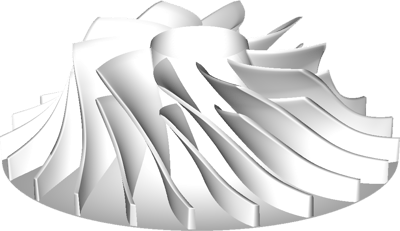The China North Engine Research Institute (CNERI), founded in 1958, is a professional vehicle engines development laboratory located in Datong, China. CNERI belongs to China North Industries Group Corporation and is tasked with developing high speed, powerful internal combustion engines for motor vehicles, ships, engineering machinery and power generation.
CNERI engineers used a commercially available 3D Inverse Design software system, TURBOdesign Suite by Advanced Design Technology, to rapidly develop a new centrifugal compressor for an heavy truck turbocharger that provides superior, performance. They found that 3D inverse design methodology was the best way to achieve their goals.

Fig. 1. CAD model of the 3D compressor as output from TURBOdesign1.
Conventional design starts from an assumed blade shape whose performance is evaluated by computational fluid dynamics (CFD) codes. However, since the flow field is highly complex and three-dimensional, and there is no direct relationship between the blade geometry and flow field, the design process has to rely on designer experience gained through many years of trial and error. Generally speaking, experienced designers can achieve good designs by following closely what has worked in the past. However, such an approach can, inadvertently, result in a reduction of the explored design space as the designer tends to operate within his comfort zone. Hence, this approach makes it more difficult to achieve designs beyond previous experience, and this is one of the main causes of increasing difficulty in achieving further performance improvements.
In the 3D Inverse Design approach, the blade geometry is computed for a given pressure or loading distribution. It’s a well known fact that the 3D pressure distribution controls the viscous behavior of the flow, and hence, by controlling the 3D pressure field, it is possible to directly use the detailed information provided by CFD solutions to arrive at a choice of optimum loading to control particular sources of performance loss in turbomachines. The 3D inverse design approach therefore allows designers to directly use knowledge of fluid dynamics, as provided by CFD and detailed measurements, to arrive at breakthrough solutions that solve particular adverse flow phenomena.
Inside the case study you can see how they were able to develop a unique centrifugal compressor.
Mehrdad Zangeneh
Mehrdad Zangeneh is Founder and Managing Director of Advanced Design Technology and professor of Thermofluids at University College London.
View All Articles






Share This Post